NorthWales
A Quick Visit to a Distant Past
24/07/20 22:42
Trefignath
With the long days and longer weeks at work over the last five months – not to mention historic/tourist sites and parking bays being closed throughout Wales – I haven't done any of my archaeological visits since last year. Today I was over in Anglesey again delivering to the Morrisons by Holyhead. It was only a few weeks ago that I saw from the main road a neolithic tomb just a couple of minutes from the supermarket. Today I decided (after getting a wee shop in at Morrisons) to pop over to it. Funnily enough now with all the summer's growth of trees and bushes the site is not as evident from the A55 as it was when I saw it earlier.
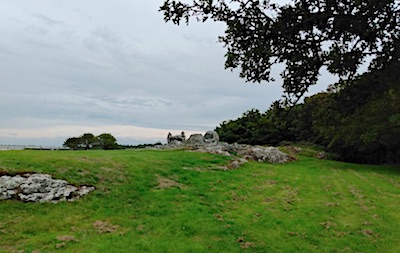
Trefignath view from site entrance/stile
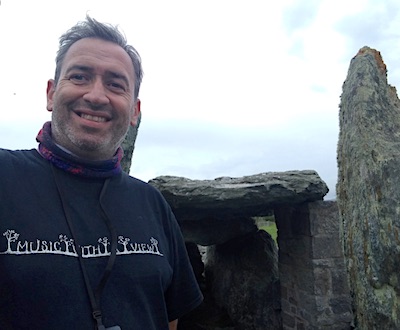
Trefignath Selfie
There is no proper parking for the site. But it is by a new and relatively quiet road, evidently built for an industrial park which is yet to be built. After a short walk from the road, along a narrow partially tarmac path, there is a stile entrance into the site. There actually don't appear to be any signs, at least in the direction I came from, showing where the site is, which is a little odd. Maybe it is to do with all the 'new' roads along the edge of the area.
The site at Trefignath is a mind boggling 5300 years old, according to the information board at the site – charcoal found at the site date to 3300 BCE (plus or minus 70 years). It comprises three chambers built over a long period in the Severn-Cotswold cairn form. The first chamber has some very large stones forming the walls but no roof. There is little evidence on the surface of the second chamber. The best one (at least in terms of having a roof) is the third more recent chamber.
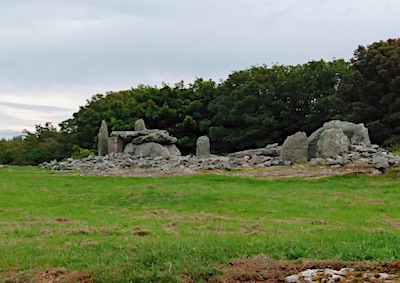
Burial chamber view chamber one nearest and main chamber three furthest away
Whilst the site doesn't appear to be signposted there is at least an information board half way along the northern western boundary of the site outlining the history of the site and describing the three chambers of the tombs. Unlike other sites I've visited, which have been at least partially excavated into the ground, due to the geology the chambers appear to have been constructed directly onto the bedrock. Some of the stones used are very large, particularly the large wall stone of Chamber 1, the two vertical stones at the entrance of Chamber 3 and the roof stones of that chamber.
It has been heavily reconstructed (despite the lack of much of its form) and you will see brick and mortar columns supporting some of the stones in Chamber 3.
The sides of the cairn are made with loose stones and rocks. I'm not sure whether originally it would have been left as stone or grassed. I assume it would have just been stone. Why this spot was chosen was for the cairn unclear. Who knows, maybe it was where the people lived, or maybe they just wanted to be handy for the Morrisons. An alignment of stones at the site though are apparently in just 1 degree away from the winter solstice sunrise, which I guess may be more relevant than the supermarket.
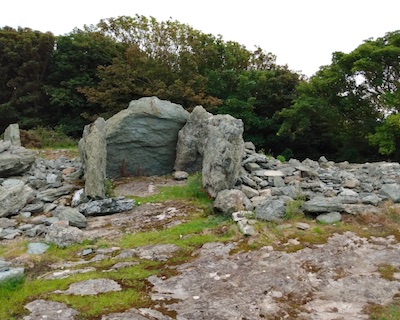
Chamber one
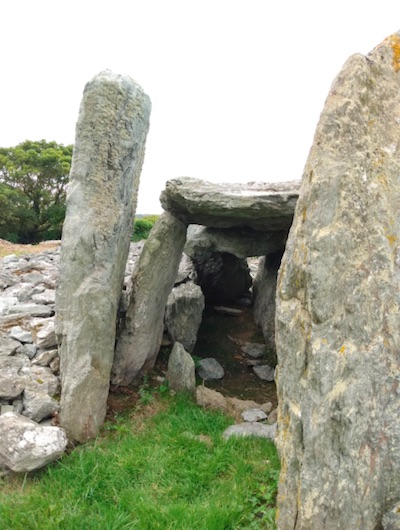
Chamber three
If you are visiting this site you may also want to go to the single, large standing stone "Ty Mawr" several hundred metres to the north of the site in another field–you can't miss it from the road. I didn't go over to see it on this occasion as parking again didn't look straightforward and because I needed to get home via a debrief with the one parcel I had been unable to deliver (mistakenly on my route – Grrrr.)
It was only a tiny diversion from my return home and I didn't spend long here, but it was nice to take the opportunity to visit the site. Definitely worth a visit if you'd otherwise be whizzing past on the way to or from Holyhead. It's not up there with Capel Garmon, but then again it is a very different position and up to 2000 years older!
If you fancy seeing Capel Garmon take a look at my blog from November, which was now several life times ago.
With the long days and longer weeks at work over the last five months – not to mention historic/tourist sites and parking bays being closed throughout Wales – I haven't done any of my archaeological visits since last year. Today I was over in Anglesey again delivering to the Morrisons by Holyhead. It was only a few weeks ago that I saw from the main road a neolithic tomb just a couple of minutes from the supermarket. Today I decided (after getting a wee shop in at Morrisons) to pop over to it. Funnily enough now with all the summer's growth of trees and bushes the site is not as evident from the A55 as it was when I saw it earlier.

Trefignath view from site entrance/stile

Trefignath Selfie
There is no proper parking for the site. But it is by a new and relatively quiet road, evidently built for an industrial park which is yet to be built. After a short walk from the road, along a narrow partially tarmac path, there is a stile entrance into the site. There actually don't appear to be any signs, at least in the direction I came from, showing where the site is, which is a little odd. Maybe it is to do with all the 'new' roads along the edge of the area.
The site at Trefignath is a mind boggling 5300 years old, according to the information board at the site – charcoal found at the site date to 3300 BCE (plus or minus 70 years). It comprises three chambers built over a long period in the Severn-Cotswold cairn form. The first chamber has some very large stones forming the walls but no roof. There is little evidence on the surface of the second chamber. The best one (at least in terms of having a roof) is the third more recent chamber.

Burial chamber view chamber one nearest and main chamber three furthest away
Whilst the site doesn't appear to be signposted there is at least an information board half way along the northern western boundary of the site outlining the history of the site and describing the three chambers of the tombs. Unlike other sites I've visited, which have been at least partially excavated into the ground, due to the geology the chambers appear to have been constructed directly onto the bedrock. Some of the stones used are very large, particularly the large wall stone of Chamber 1, the two vertical stones at the entrance of Chamber 3 and the roof stones of that chamber.
It has been heavily reconstructed (despite the lack of much of its form) and you will see brick and mortar columns supporting some of the stones in Chamber 3.
The sides of the cairn are made with loose stones and rocks. I'm not sure whether originally it would have been left as stone or grassed. I assume it would have just been stone. Why this spot was chosen was for the cairn unclear. Who knows, maybe it was where the people lived, or maybe they just wanted to be handy for the Morrisons. An alignment of stones at the site though are apparently in just 1 degree away from the winter solstice sunrise, which I guess may be more relevant than the supermarket.

Chamber one

Chamber three
If you are visiting this site you may also want to go to the single, large standing stone "Ty Mawr" several hundred metres to the north of the site in another field–you can't miss it from the road. I didn't go over to see it on this occasion as parking again didn't look straightforward and because I needed to get home via a debrief with the one parcel I had been unable to deliver (mistakenly on my route – Grrrr.)
It was only a tiny diversion from my return home and I didn't spend long here, but it was nice to take the opportunity to visit the site. Definitely worth a visit if you'd otherwise be whizzing past on the way to or from Holyhead. It's not up there with Capel Garmon, but then again it is a very different position and up to 2000 years older!
If you fancy seeing Capel Garmon take a look at my blog from November, which was now several life times ago.
Comments
Capel Garmon: a clearer visit
21/11/19 22:47
It was a lovely day on Monday this week and I was back in North Wales around Llanwrst and Trefriw, including getting down as far as Capel Garmon. I switched the order of a couple of drops so that I could finish the route there in order to take the opportunity to revisit the neolithic burial chamber - on a much nicer day than two weeks or so ago when it was very wet and immensely grey. It gave me the chance to go and look at the Gorsedd Stone on the adjacent rise. I didn't have my camera with me but got some okay shots with my lightly battered phone instead. Easy to get nice shots when the day was so nice.
So here they are (the previous photos, and the write up, can be seen here).
As well as being much clearer in the late afternoon light I also got proper shots where you can see the massive cover stone above one of the chambers. In addition to this I went over to the Gorsedd (throne) Stone on the adjacent rise which is obviously part of the site assemblage.
View of the Capel Garmon burial chamber.
View into the burial chamber.
Covered chamber.
Beautiful view from the covered chamber.
Massive stone covering one of the chambers.
Original entrance way into the burial chamber (with chambers on either side of it). Gorsedd Stone on rise roughly in line with it.
Second, uncovered, chamber
Gorsedd Stone
Gorsedd Stone (burial chamber in background on right side)
All in all a worthwhile revisit on a beautiful afternoon.
So here they are (the previous photos, and the write up, can be seen here).
As well as being much clearer in the late afternoon light I also got proper shots where you can see the massive cover stone above one of the chambers. In addition to this I went over to the Gorsedd (throne) Stone on the adjacent rise which is obviously part of the site assemblage.
View of the Capel Garmon burial chamber.
View into the burial chamber.
Covered chamber.
Beautiful view from the covered chamber.
Massive stone covering one of the chambers.
Original entrance way into the burial chamber (with chambers on either side of it). Gorsedd Stone on rise roughly in line with it.
Second, uncovered, chamber
Gorsedd Stone
Gorsedd Stone (burial chamber in background on right side)
All in all a worthwhile revisit on a beautiful afternoon.
Gwytherin Stones
10/11/19 12:32
My third visit in a week to see some ancient stones was to see the Gwytherin Stones. This is a line of four stones in the churchyard of St. Winefred's Church in Gwytherin. As a simple line of stones within a church environment there is not much in the way of setting for them to be able to date them and the age of them are disputed from Bronze Age through to something more modern. I won't say who knows, it's a no-one knows - at least yet. The church itself dates to 1869 but there is thought to have been a church on the site since around 600AD.
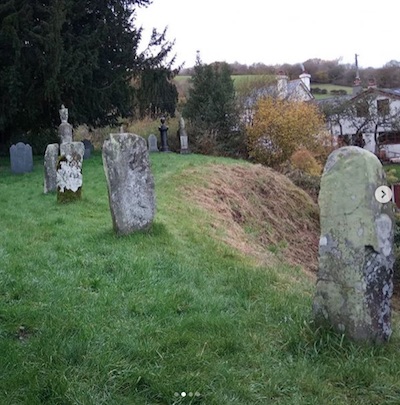
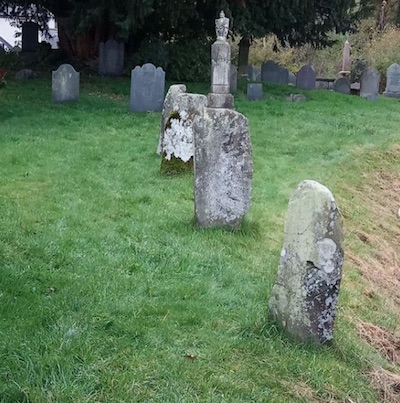
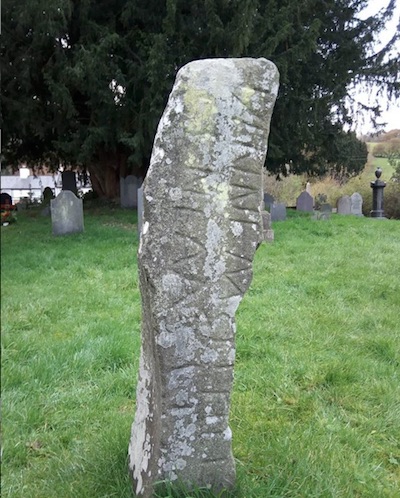
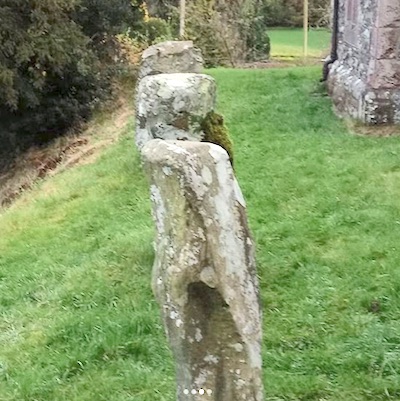
The stones are each around 1m high and one of them (the western most one) has writing on it. They are aligned perfectly in an east-west direction. They are the closest to the church and it is nice that they have been left in place and not destroyed during its development. You do wonder if other stones may have been on the site previously and how they may have been arranged. The four stones sit above a steep slope down to a stream, a tributary to the nearby River Cledwen, and I wonder how it has moved historically - has it eaten into this embankment and taken away archaeology?
As well as the stones the churchyard has three ancient yews. Three? That's just greedy.
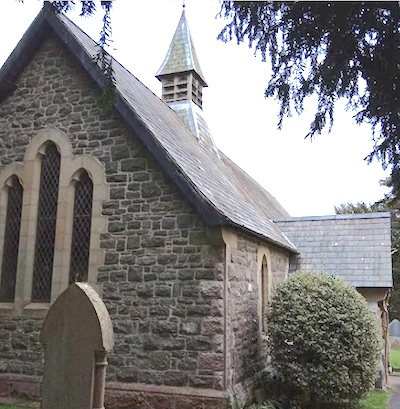
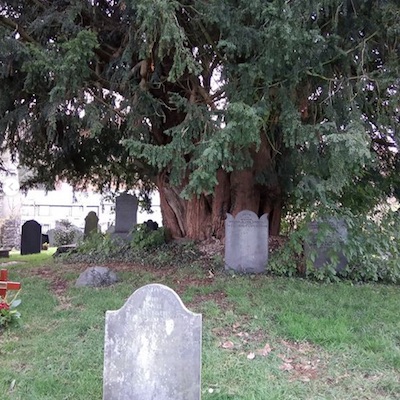
Gwytherin itself is a pretty little village and one literary claim to fame is that it is the setting in 'A Morbid Taste for Bones' the first book of Ellis Peter's Cadfael series (written in 1977 and set in 1137)/ Haven't read it. Wonder if the stones are mentioned by the monks? Will have to buy the book, and maybe read it in front of a roaring fire in the Lion Inn, which is lovely looking old pub opposite the church.
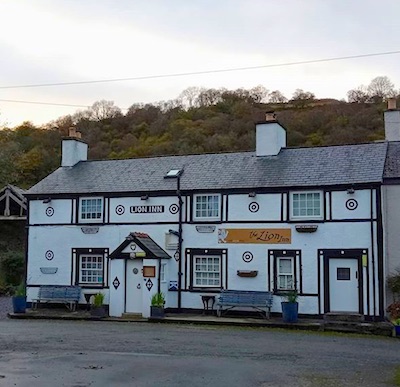




The stones are each around 1m high and one of them (the western most one) has writing on it. They are aligned perfectly in an east-west direction. They are the closest to the church and it is nice that they have been left in place and not destroyed during its development. You do wonder if other stones may have been on the site previously and how they may have been arranged. The four stones sit above a steep slope down to a stream, a tributary to the nearby River Cledwen, and I wonder how it has moved historically - has it eaten into this embankment and taken away archaeology?
As well as the stones the churchyard has three ancient yews. Three? That's just greedy.


Gwytherin itself is a pretty little village and one literary claim to fame is that it is the setting in 'A Morbid Taste for Bones' the first book of Ellis Peter's Cadfael series (written in 1977 and set in 1137)/ Haven't read it. Wonder if the stones are mentioned by the monks? Will have to buy the book, and maybe read it in front of a roaring fire in the Lion Inn, which is lovely looking old pub opposite the church.

The Gop
05/11/19 11:58
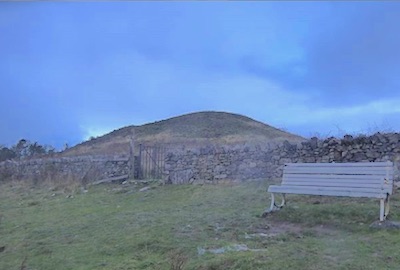
The Gop
Saturday, another wet autumn day and another Neolithic site in North Wales. Yep, after the previous day's visit to Capel Garmon this time I found myself near to Trelawnyd and The Gop. As I had the time I decided to give it a go and once more, despite squally showers and continuing camera issues, it was well worth the small detour.
I'd only found out about the place the previous night when reading about it both online and in Julian Cope's excellent tome, 'The Modern Antiquarian'. As I approached Trelawnyd from the west in the afternoon I looked up the hillside to see if I could see The Gop and was surprised at how distinct and obvious it was - in so much as I'd travelled this road so many times and never noticed it. Now I know it's there I will never not see it.
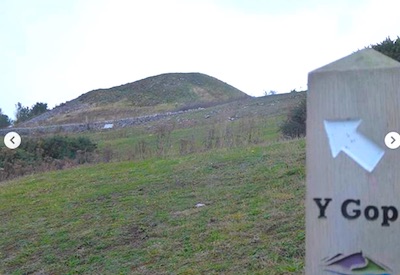
View of The Gop walking up from the path from Trelawnyd
Of course this area is full of hills and sometimes any strange shapes can be interpreted as due to geology or often down to quarrying. In this case The Gop is a man made hill (Neolithic c 3-4000 years old) on top of a hill. It is the second largest Neolithic mound behind only the very famous Silbury Hill. Which makes you wonder why this place isn't more well known. I suppose being a hill on a hill it is less obvious than being a hill on a plain like Sllbury. Unlike Silbury you can walk right up to The Gop and onto it too. Which I did. I parked at the bottom of a path in the village and took the short walk via just one stile and a kissing gate. The path up to The Gop was wet, muddy, quite steep and very slippy. It was actually easier getting up the mound itself.
The mound is massive, but because of its place like a pimple on a hill you really don't feel it from distance. In some places, especially on the northern side of the mound, you can see the construction materials which comprises fragments of limestone, much of which are incredibly small in that you can hold multiple pieces in your hand. To think of the number of people and time it would have taken to construct it is a bit mind boggling.
In the late 19th century there was investigations into the mound looking for burial chambers (or dare I say treasure) which didn't find anything. That doesn't mean there's nothing there given similar early investigation of Sutton Hoo. Given the type of material (loose limestone) it must have been hellish to dig. Nearby at lower levels of the hill are caves where ancient human and animal remains have been found and could well be linked with the site. I can't see it would have been constructed as a hill fort - you'd be better protecting the existing hill top rather than building the hill on a hill - not to mention the issues with constructing on it. Surely the mound is related to the importance of the caves?
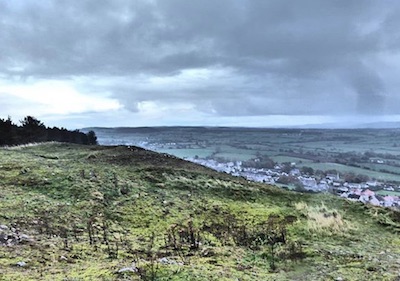
View south east from The Gop
The views from The Gop are great. Or rather would have been on a better day. Apparently on a clear day you can see Blackpool Tower (the universal SI unit for distance viewing in the north west). I was told this by the only couple I saw whilst on my jaunt. They had come up walking their very bouncy, wet, black Labrador. He bounded up to investigate me and seemed an inordinately happy soul. Unfortunately he managed to time one bounce such that the lady owner who was leaning down to say nice things to him got hit in her chin by his head. Bit through her lip, she did. Ouch! Love can be painful.
After they had gone I decided to go down the northern side of the mound to look at where the limestone is exposed towards the base. It was wet and slippy. And yes, I slipped. I managed yet again to fall in glorious slow motion whilst twisting and moving to avoid landing on my shoulder (the one which is already dislocated), and side where my phone was and land so I didn't risk my fingers or arms too much. Basically my arse took the brunt of it and other than being wet I survived without injury or damage to technology. And no-one saw it either. Huzzah!
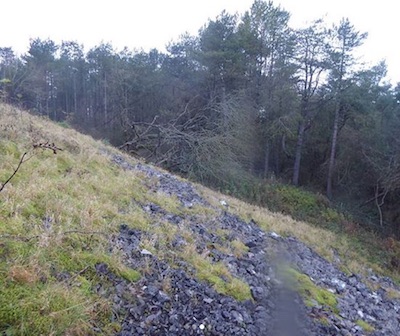
The northern slope of The Gop, where you can see the building materials
When you see the material and the slope from that position (see fourth pic, below) you get an idea of the size of the place and the effort that must have gone into its construction. It was easier to climb back up the mound from the side - I'm not sure if it was practical to walk around, with the long days of rain I feared further slippage events or a twisting of an ankle. And getting down the mound on the south side is easier as there are paths (after a fashion).
Like Capel Garmon it only took me around half an hour from parking to returning. And the benefit to myself far outweighed getting home that half hour earlier. Next time I'll go when its a blue sky and I'll check out where the caves are (though they are closed off now I believe).
So, lastly, if you're ever on the road through Trelawnyd look up the hill to The Gop and see it for the first time. Then maybe even go and see it close up. On a blue sky day you may be able to see Blackpool Tower (incidentally I would suggest this is about as close as you would want to get to Blackpool).
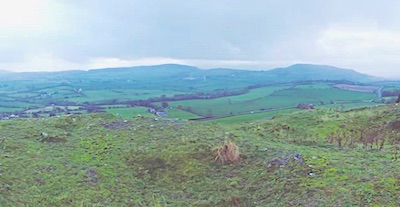
View south west from The Gop
Capel Garmon
01/11/19 21:57
Have been around Capel Garmon, which is a few miles south of Llanrwst, a few times over the last couple of months. The very first time I went through I saw this sign to a burial chamber:
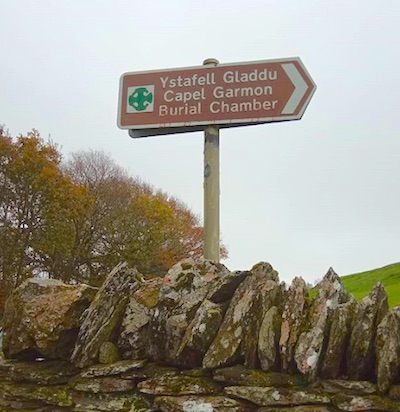
Sign at the main road
When I got home I looked it up on Dr Google and found that it was for a very interesting burial chamber indeed. It is estimated to be around 3500 years old and the site was used for a long time - including by the Beaker people. The working day doesn't always give me half an hour to take a break (or have lunch) but I said to myself if I got the chance sometime I'd go down and take a look. As it happens, whilst there is a bit of walk from the main road, it only took me about 20 minutes to get there and back. It was a shame it was wet and grey day (and that my camera was acting up) but I took a few shots. It was well worth using 20 minutes of my day to pop down to see it.
As you walk down the road towards the site the first thing you see is a massive stone - known as a Gorsedd, or throne - which on the adjoining rise, which is associated with the chamber. The burial chamber is not well signposted (one sign is missing from one of the gates) but as you walk down the private road to the farm there is a swing (kissing) gate through to the public footpath (no real path), which at the time was pretty muddy. And fifty yards up from there is another gate (with the missing sign), go through this and then you should see the fenced off area of the chamber. This field was even wetter than the first one but it has been a very wet couple of weeks.
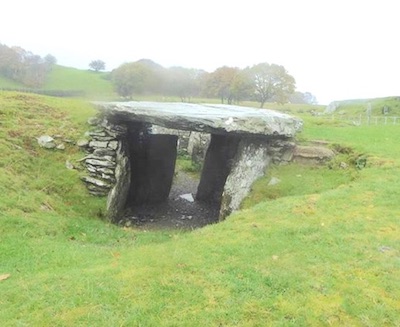
Current entrance into the barrow beneath the one remaining top stone.
There was no soul around though somehow one of the sheep from the surrounding field had somehow got in for a gander himself. Not sure how he'd got in through a swing gate. The chamber is of a type known as Severn-Cotswold construction and is one of the most northern examples of it (though Trefignath on Anglesey is of the same classification).
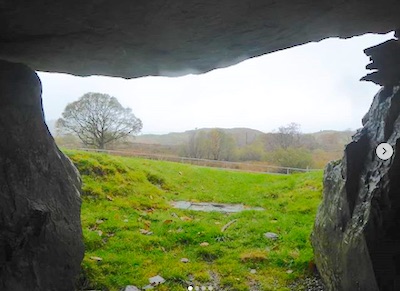
View out of the barrow from the first circular chamber
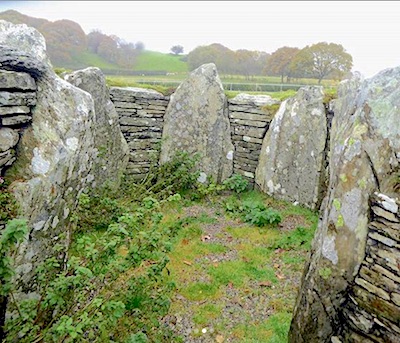
Second circular chamber, which is uncoverered
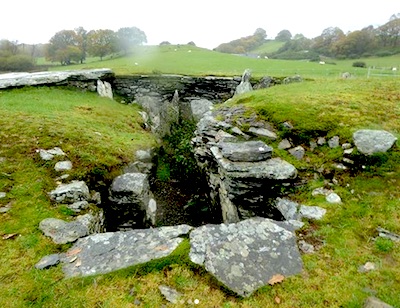
This would have been the original entrance into the barrow - with the two chambers either side at the end of the passage. The Gorsedd stone is on the rise in a straight line from this entrance to the chamber.
I'll definitely go and see it again when I get the chance. Preferably when my camera isn't acting up and on a blue sky and dry-underfoot kind of day. I'll also go and look at the Gorsedd.
It's got me fired up to keep an eye out for other ancient sites whilst I'm traveling around. And I've now found, for example, I've regularly driven past The Gop cairn hill which is the second largest Neolithic mound coming behind only Silbury Hill. I have never noticed it (or heard of it before). I also need to see how long it would take to get along to the Druids' Circle above Penmaenmawr; the Four Stones of Gwytherin; and the stones of Tal y Fan.
Unfortunately November on the run up towards Christmas and of course the shorter daylight… well all in all not ideal to try and fit these in now. Though I'll keep my eye out for any which are near a road side.

Sign at the main road
When I got home I looked it up on Dr Google and found that it was for a very interesting burial chamber indeed. It is estimated to be around 3500 years old and the site was used for a long time - including by the Beaker people. The working day doesn't always give me half an hour to take a break (or have lunch) but I said to myself if I got the chance sometime I'd go down and take a look. As it happens, whilst there is a bit of walk from the main road, it only took me about 20 minutes to get there and back. It was a shame it was wet and grey day (and that my camera was acting up) but I took a few shots. It was well worth using 20 minutes of my day to pop down to see it.
As you walk down the road towards the site the first thing you see is a massive stone - known as a Gorsedd, or throne - which on the adjoining rise, which is associated with the chamber. The burial chamber is not well signposted (one sign is missing from one of the gates) but as you walk down the private road to the farm there is a swing (kissing) gate through to the public footpath (no real path), which at the time was pretty muddy. And fifty yards up from there is another gate (with the missing sign), go through this and then you should see the fenced off area of the chamber. This field was even wetter than the first one but it has been a very wet couple of weeks.

Current entrance into the barrow beneath the one remaining top stone.
There was no soul around though somehow one of the sheep from the surrounding field had somehow got in for a gander himself. Not sure how he'd got in through a swing gate. The chamber is of a type known as Severn-Cotswold construction and is one of the most northern examples of it (though Trefignath on Anglesey is of the same classification).

View out of the barrow from the first circular chamber

Second circular chamber, which is uncoverered

This would have been the original entrance into the barrow - with the two chambers either side at the end of the passage. The Gorsedd stone is on the rise in a straight line from this entrance to the chamber.
I'll definitely go and see it again when I get the chance. Preferably when my camera isn't acting up and on a blue sky and dry-underfoot kind of day. I'll also go and look at the Gorsedd.
It's got me fired up to keep an eye out for other ancient sites whilst I'm traveling around. And I've now found, for example, I've regularly driven past The Gop cairn hill which is the second largest Neolithic mound coming behind only Silbury Hill. I have never noticed it (or heard of it before). I also need to see how long it would take to get along to the Druids' Circle above Penmaenmawr; the Four Stones of Gwytherin; and the stones of Tal y Fan.
Unfortunately November on the run up towards Christmas and of course the shorter daylight… well all in all not ideal to try and fit these in now. Though I'll keep my eye out for any which are near a road side.